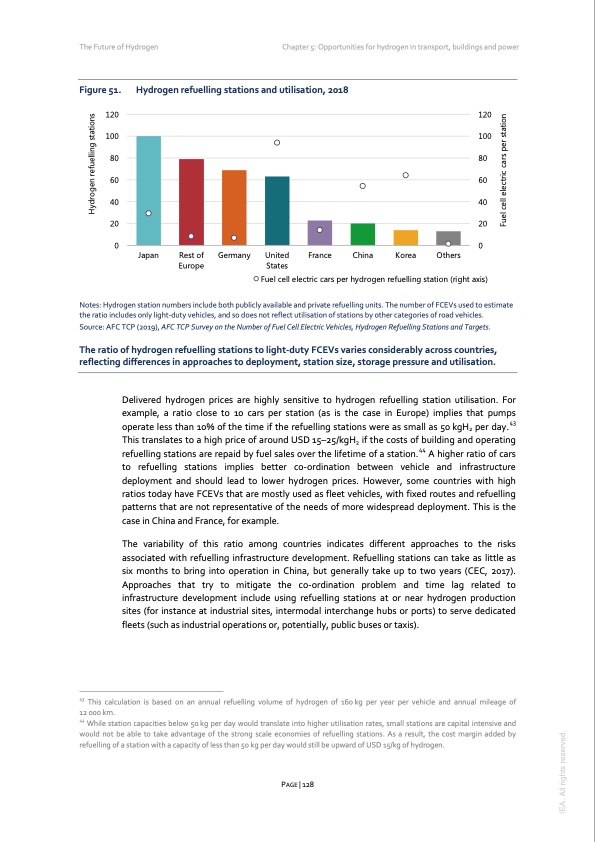
PDF Publication Title:
Text from PDF Page: 128
The Future of Hydrogen Chapter 5: Opportunities for hydrogen in transport, buildings and power Figure 51. 120 100 80 60 40 20 Hydrogen refuelling stations and utilisation, 2018 120 100 80 60 40 20 00 Japan Rest of Germany United France China Korea Others Europe States Fuel cell electric cars per hydrogen refuelling station (right axis) Notes: Hydrogen station numbers include both publicly available and private refuelling units. The number of FCEVs used to estimate the ratio includes only light-duty vehicles, and so does not reflect utilisation of stations by other categories of road vehicles. Source: AFC TCP (2019), AFC TCP Survey on the Number of Fuel Cell Electric Vehicles, Hydrogen Refuelling Stations and Targets. The ratio of hydrogen refuelling stations to light-duty FCEVs varies considerably across countries, reflecting differences in approaches to deployment, station size, storage pressure and utilisation. Delivered hydrogen prices are highly sensitive to hydrogen refuelling station utilisation. For example, a ratio close to 10 cars per station (as is the case in Europe) implies that pumps operate less than 10% of the time if the refuelling stations were as small as 50 kgH2 per day.43 This translates to a high price of around USD 15–25/kgH2 if the costs of building and operating refuelling stations are repaid by fuel sales over the lifetime of a station.44 A higher ratio of cars to refuelling stations implies better co-ordination between vehicle and infrastructure deployment and should lead to lower hydrogen prices. However, some countries with high ratios today have FCEVs that are mostly used as fleet vehicles, with fixed routes and refuelling patterns that are not representative of the needs of more widespread deployment. This is the case in China and France, for example. The variability of this ratio among countries indicates different approaches to the risks associated with refuelling infrastructure development. Refuelling stations can take as little as six months to bring into operation in China, but generally take up to two years (CEC, 2017). Approaches that try to mitigate the co-ordination problem and time lag related to infrastructure development include using refuelling stations at or near hydrogen production sites (for instance at industrial sites, intermodal interchange hubs or ports) to serve dedicated fleets (such as industrial operations or, potentially, public buses or taxis). 43 This calculation is based on an annual refuelling volume of hydrogen of 160 kg per year per vehicle and annual mileage of 12 000 km. 44 While station capacities below 50 kg per day would translate into higher utilisation rates, small stations are capital intensive and would not be able to take advantage of the strong scale economies of refuelling stations. As a result, the cost margin added by refuelling of a station with a capacity of less than 50 kg per day would still be upward of USD 15/kg of hydrogen. PAGE | 128 IEA. All rights reserved. Hydrogen refuelling stations Fuel cell electric cars per stationPDF Image | The Future of Hydrogen 2019

PDF Search Title:
The Future of Hydrogen 2019Original File Name Searched:
the_future_of_hydrogen.pdfDIY PDF Search: Google It | Yahoo | Bing
NFT (Non Fungible Token): Buy our tech, design, development or system NFT and become part of our tech NFT network... More Info
IT XR Project Redstone NFT Available for Sale: NFT for high tech turbine design with one part 3D printed counter-rotating energy turbine. Be part of the future with this NFT. Can be bought and sold but only one design NFT exists. Royalties go to the developer (Infinity) to keep enhancing design and applications... More Info
Infinity Turbine IT XR Project Redstone Design: NFT for sale... NFT for high tech turbine design with one part 3D printed counter-rotating energy turbine. Includes all rights to this turbine design, including license for Fluid Handling Block I and II for the turbine assembly and housing. The NFT includes the blueprints (cad/cam), revenue streams, and all future development of the IT XR Project Redstone... More Info
Infinity Turbine ROT Radial Outflow Turbine 24 Design and Worldwide Rights: NFT for sale... NFT for the ROT 24 energy turbine. Be part of the future with this NFT. This design can be bought and sold but only one design NFT exists. You may manufacture the unit, or get the revenues from its sale from Infinity Turbine. Royalties go to the developer (Infinity) to keep enhancing design and applications... More Info
Infinity Supercritical CO2 10 Liter Extractor Design and Worldwide Rights: The Infinity Supercritical 10L CO2 extractor is for botanical oil extraction, which is rich in terpenes and can produce shelf ready full spectrum oil. With over 5 years of development, this industry leader mature extractor machine has been sold since 2015 and is part of many profitable businesses. The process can also be used for electrowinning, e-waste recycling, and lithium battery recycling, gold mining electronic wastes, precious metals. CO2 can also be used in a reverse fuel cell with nafion to make a gas-to-liquids fuel, such as methanol, ethanol and butanol or ethylene. Supercritical CO2 has also been used for treating nafion to make it more effective catalyst. This NFT is for the purchase of worldwide rights which includes the design. More Info
NFT (Non Fungible Token): Buy our tech, design, development or system NFT and become part of our tech NFT network... More Info
Infinity Turbine Products: Special for this month, any plans are $10,000 for complete Cad/Cam blueprints. License is for one build. Try before you buy a production license. May pay by Bitcoin or other Crypto. Products Page... More Info
| CONTACT TEL: 608-238-6001 Email: greg@infinityturbine.com | RSS | AMP |